One huge pumpkin can go a very long way, without a bit of it going to waste.
I was recently given a pumpkin by my uncles, tenderly raised by their green fingers, in the midst of an olive grove, overlooking the Mediterranean sea. This pumpkin was about the size of a long oval summer watermelon. It didn't weigh as much as a watermelon (which would have weighed at least ten kilos), because of its hollow interior. When I first brought it home, everyone wondered what I would end up doing with it, including myself.
"You're not feeding us pumpkin every day, Maria," lamented my husband.
"What can you cook with pumpkin, Mum?" asked my adventurous daughter.
"I don't like it, Mum," my white-food-only-please son declared.
Pumpkin is not a popular vegetable in Crete. It is sold in greengrocers', but it is not often asked for by customers. Pumpkin is usually cooked by those who have pumpkins growing in their gardens, or people given pumpkins by local farmers. In Crete, they are usually turned into savoury pies. Some farmers use pumpkin as animal feed. Just lately, pumpkins have taken on a decorative nature, due to the rise in popularity of American culture and their association with Halloween. Decorated pumpkins are sometimes seen in ex-pat American-Cretans' homes.
An American friend of mine told me how delicious pumpkin is when you fry it. Fried food may be unhealthy for you, but at least we fry our food using only olive oil. My mother-in-law loved this fried pumpkin; in fact, we all did.


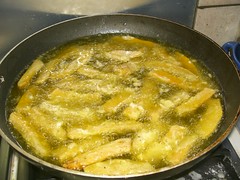
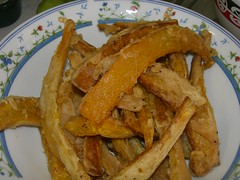
Pumpkin chips, by Dimitra Sergakis: dredge the pumpkin chips in seasoned flour, then dip in ice-cold water and shake off excess water, then dredge again in the flour, and cook in very hot olive oil till crispy, then drain on kitchen paper. Cook in small batches to keep the oil hot...
Despite smelling like heaven as it was cooking in the oven, Susan's cake wasn't very popular in my house. Where did I go wrong? I didn't; my Cretan family is simply not used to ginger, cinnamon and clove aromas in their cakes and sweets. These spices are very reminiscent of autumn and cold weather; they are not overly used in the local cuisine, hence my family simply wasn't accustomed to them. Some argue that it is all in the genes; either you have a predisposition for certain foods, or you don't want to go near them, an explanation often given for lactose intolerance in certain cultural groups, eg Asians and Native Americans.
Despite my Greek genes, I was brought up in a gingerbread and gingernut culture, and all those Northern European recipes that were popular in the New Zealand climate, with cool summers and cold winters. In Crete, cinnamon and cloves are mainly used in honey-dipped sweets like melomakarona (Christmas biscuits) and baklava. But my pumpkin cake did not go to waste. Half was shared among my colleagues at work (it was a big hit), while the other half was eaten by the children during their morning break at school - sliced, with chocolate spread on one side. They loved it.
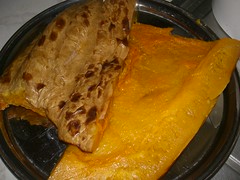

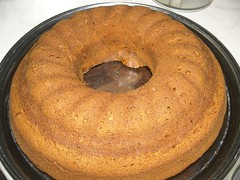

Susan's pumpkin bread: she has a very good technique for softening the pumpkin...
Pumpkin soup is always welcome in the winter. It goes well with curry spices, some more heavy aromas that are not common in the Cretan kitchen; another recipe enjoyed principally by myself (which is why I didn't make it with this pumpkin this time round - I'm waiting for the next pumpkin to arrive).
  |
The famous Gordon Ramsay pumpkin soup that I've been making long before I found out who he was...
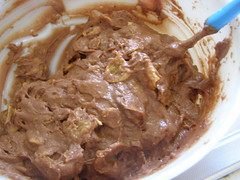
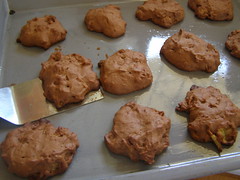
My very own pumpkin cookies, specially created for Thanksgiving (recipe will be posted on 27 November), based on the idea of using cornflakes in a New Zealand biscuit, the afghan.
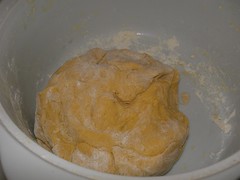
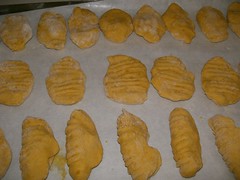
Aglaia Kremezis' pumpkin gnocchi, oil and seasonings added ...
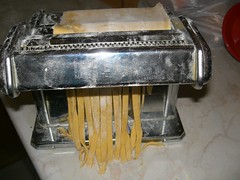

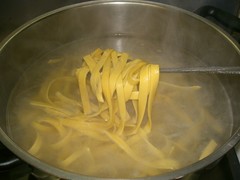
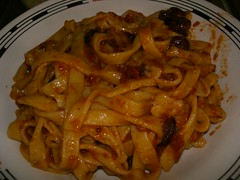
Fettuccine a la puttanesca using pumpkin gnocchi dough...
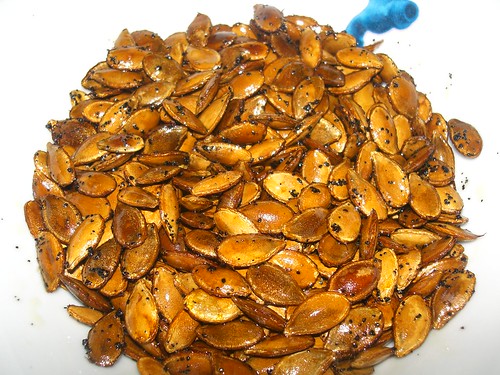
Roasted pumpkin seeds: as Elise says, don't bother opening them to eat only the seed; they taste good whole.
None of this pumpkin was binned, except for a very thin layer of outer skin. The whole pumpkin was treated with the respect it deserves as a food item and a commodity. It constituted a substantial part of our meals, was eaten in a variety of different forms, and was enjoyed by a lot of people. In these hard economic times, it doesn't make sense to shirk at the thought of cooking the same food when you can cook it differently using the same ingredients in a different combination. We cannot afford to waste food any longer.
This is my entry for this week's Weekend herb Blogging, hosted by Siri from Siri's Corner.
The pumpkin cookies made an excellent bento school lunchbox filler. To make sure that the children would eat them, I added cocoa and cornflakes. The pumpkin pulp went by unnoticed. But it was there, making these biscuits extra healthy.


My very own pumpkin cookies, specially created for Thanksgiving (recipe will be posted on 27 November), based on the idea of using cornflakes in a New Zealand biscuit, the afghan.
I originally made the pumpkin gnocchi as a way to use up the pumpkin excess in my kitchen, after seeing a Sunday newspaper supplement featuring Aglaia Kremezi's pumpkin recipes. She tells us that the Spanish conquistadors mistook the pumpkin for a new variety of melon. As I was making the pumpkin gnocchi, I suddenly had another idea for making pasta with the same dough...


Aglaia Kremezis' pumpkin gnocchi, oil and seasonings added ...
... pumpkin fettuccine, using my late mother's pasta machine. This was an absolute hit in the house. The children were most intrigued that they could make their own spaghetti; they now want to make it every week...




Fettuccine a la puttanesca using pumpkin gnocchi dough...
But the most spectacular pumpkin recipe of all was Susan's pumpkin honey pie. One taste of this, and you're sure to think you've gone to heaven. It warmed up the kitchen and sent a delicious smell through the air. I called the pie μελόπιτα - melopita: 'honey pie' - which is kind of true: it contained honey, eggs and spices, and pumpkin of course, but I preferred not to admit that part, just in case everyone got frightened into thinking that everything they ate would be turned into a pumpkin, like Cinderella's story. Half of it was enjoyed by my colleagues, while the other half was eaten by my family.
If I could make this pie a second time around, I'd have it with some ice-cream, garnished with some whipped cream and topped with a spoonful of syrupy Greek grape dessert. If my family were a little more open-minded concerning international cuisine, I'd make this pie a staple part of a Christmas dinner.
If I could make this pie a second time around, I'd have it with some ice-cream, garnished with some whipped cream and topped with a spoonful of syrupy Greek grape dessert. If my family were a little more open-minded concerning international cuisine, I'd make this pie a staple part of a Christmas dinner.
Last but not least, not even the pumpkin seeds went to waste!

Roasted pumpkin seeds: as Elise says, don't bother opening them to eat only the seed; they taste good whole.
None of this pumpkin was binned, except for a very thin layer of outer skin. The whole pumpkin was treated with the respect it deserves as a food item and a commodity. It constituted a substantial part of our meals, was eaten in a variety of different forms, and was enjoyed by a lot of people. In these hard economic times, it doesn't make sense to shirk at the thought of cooking the same food when you can cook it differently using the same ingredients in a different combination. We cannot afford to waste food any longer.
This is my entry for this week's Weekend herb Blogging, hosted by Siri from Siri's Corner.
©All Rights Reserved/Organically cooked. No part of this blog may be reproduced and/or copied by any means without prior consent from Maria Verivaki.
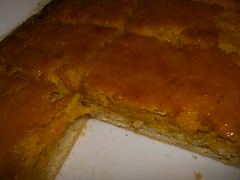
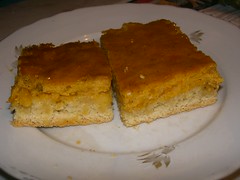
Wow! With just one pumpkin, you have been very busy and creative in the kitchen! :) Looks like you can feed and army with those delicious pumpkin recipes! :)
ReplyDeleteAmen to the humble pumpkin Maria! Wow! You certainly made good use out of it. I love all the recipes, especially those fries!
ReplyDeleteLove your frugality, Maria! Our family is the same way.
ReplyDeleteSo many excellent ways with pumpkin Maria. I will have to check out Aglaia's article since I spent 8 days at her cooking class on Kea. She is one busy woman!!!
ReplyDeleteWhat an interesting post. I will never look at a pumpkin again in the same way. Can't decide if I want some pumpkin pasta, roasted seeds or those tempting pumpkin fries right about now.
ReplyDeletequite a pumpkin Odyssey, an inspiring one too! you are not a lazy cook, and I hope your family appreciates your efforts! they are lucky!
ReplyDeleteVersatile delicious pumpkin recipes.This season I mostly used the pumpkins in baking.
ReplyDeletei was happy to share, and even happier to see the fruits of you labors....have a wonderful week!
ReplyDeleteWow! You sure showed how versatile this vegetable is! I agree with your children; that pumpkin pasta looks terrific. And all those baked goodies look wonderful, too! I bet they did make great snacks in lunches!
ReplyDeleteLiking the variety of recipes for pumpkin. I'll have to try roasting the seeds next.
ReplyDeleteTry veg stock, white wine, parmesan and roasted garlic blended with shredded spinach as a sauce for your pumpkin gnocchi. ( Courtesy of Cafe Paradiso )
Maria, you've gone "loco" for pumpkin! The last photo of the seeds has seduced me...passa-tempo anyone?
ReplyDeleteWow, these are a lot of ideas for cooking with pumpkins!
ReplyDeleteGay
merci
ReplyDelete